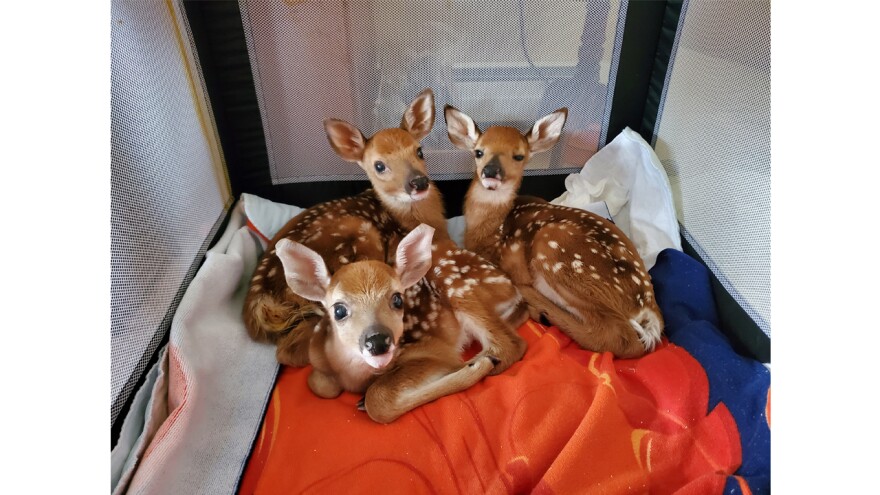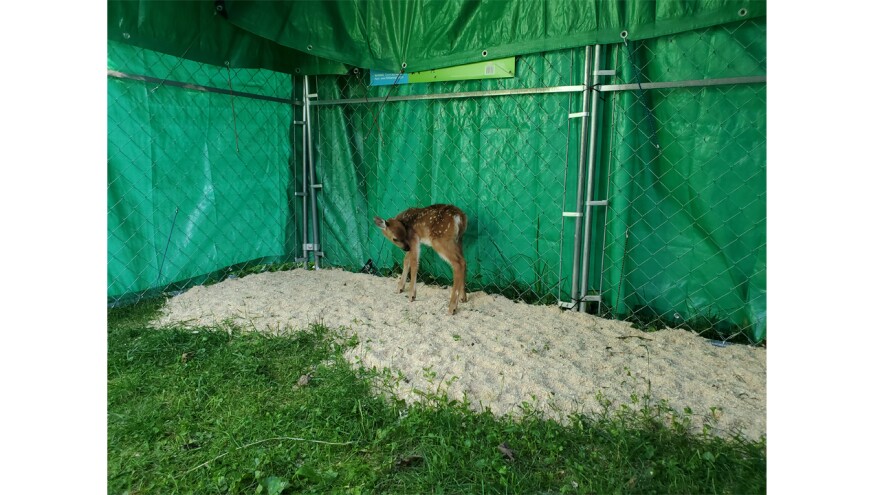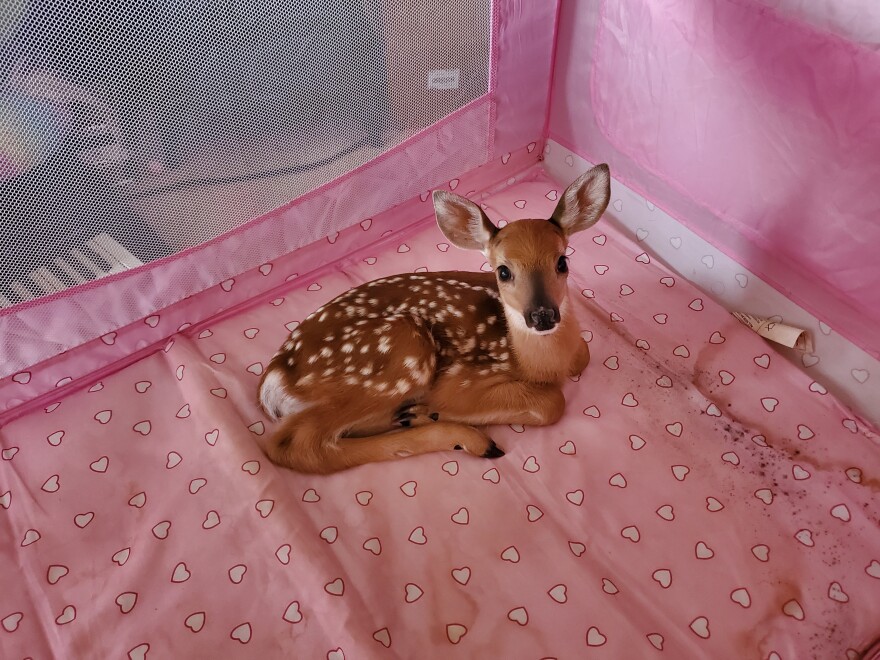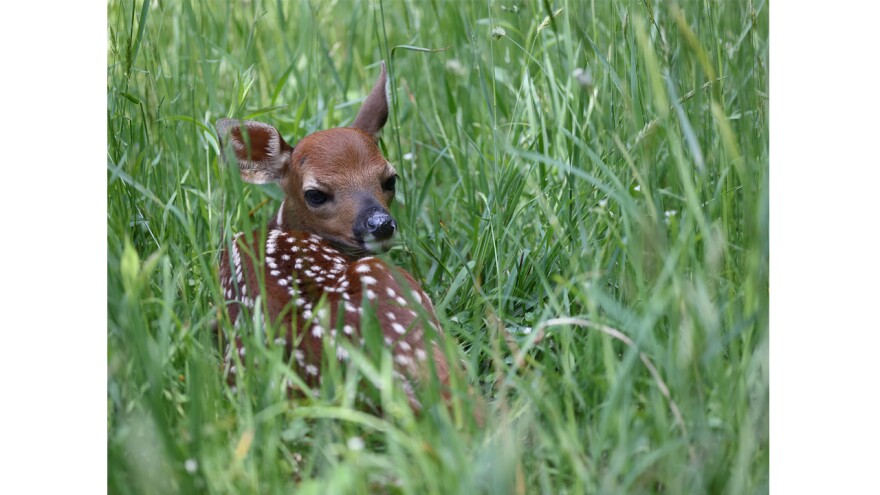STROUDSBURG, Pa. — With its cinnamon color, big brown eyes and little white spots, a baby deer can melt your heart.
But if you discover one on your property or out in the wild, Pocono Wildlife Rehabilitation's fawn specialist Jessica Metzger has two words for you: Hands off.
"Call the hotline, tell me what you're seeing, and we can better determine what's actually going on and if it truly needs help," Metzger said.
From April till June, she said she's very busy tending to the tiniest of critters, such as baby squirrels, and those most misunderstood — fawns.

"I understand," Metzger said. "They're adorable. We as humans wouldn't dream of leaving our babies alone for hours to fend for themselves."
Deer are different. That's what cervid mothers do to keep their babies alive, Metzger said.
A mother deer knows her baby doesn't have much of a scent yet, but she knows her own will draw predators right to her baby, so she makes sure the fawn is safely camouflaged and then keeps her distance.
You might not see the mother, but she's often within earshot of the fawn, Metzger said.
"Last year, almost every year, most of the fawns we got were just straight-up kidnapped," Metzger said from her home, where Pocono Wildlife has opted to rehab all of its fawns this year, something with which it experimented last spring.
"For the first two months, mom leaves them alone mostly all day. She feeds them two to four times a day, and leaves them alone.
"They're not coordinated now, they can’t outrun a predator, so their best defense is to just lay there very still and hope you don’t notice them.
"It works pretty well. Dead leaves and brush are a really good camouflage."
Urban sprawl continues to bring fawns closer to humans, which is good and bad for deer in general, Metzger said.
"The closer they are to human structures, the farther away they are from natural predators," she said.
"The tradeoff is, now they’re more visible and we’re seeing more of them. They lay up against somebody’s porch, garage, deck, and we think something’s wrong."Jessica Metzgar, fawn specialist
"The tradeoff is, now they’re more visible and we’re seeing more of them. They lay up against somebody’s porch, garage, deck, and we think, something’s wrong."
Metzger said moms return from dusk to dawn, so wait and observe if you’re worried about the fawn getting enough to eat.
The new hotline — 570-979-1363— goes directly to Metzger, who said she is happy to answer and assess the situation.
She said the new tool already is making a noticeable dent in the number of well-intended "fawn-nappings."
Most importantly, being able to talk to the public spares the babies from capture myopathy she said.
In nature, everything other than mom is a predator, so when a fawn encounters a human, its muscles tense up so hard and don't ever relax again, the physical assertion assures the baby a very painful and often slow death.

"People think they're doing the right thing by rescuing a fawn," Metzger said. "But if nothing is wrong, they're actually doing the opposite.
"Capture myopathy is very, very painful. It's the stress response. The only time they’re being handled in the wild is if a predator is picking them up.
"So when humans touch them, they shut down, causing permanent muscle damage. If it hits their lungs or heart, it is fatal.
"It can take from a couple of minutes, and they pass away easily, all the way to three months later from sustained muscle damage in heart and lungs.
"That damage is permanent. That's it. No treatment, no fixing it. So when it happens, long term, that’s rough because you don’t know when it's coming.
"You just notice that one day they‘re not keeping up, because they're not able to keep up with that blood flow to heart and lungs."
Deer are part of the cervidae family: even-toed, hooved mammals that also are called ruminants because of their four stomach chambers used to break down grass for its extended benefits, which they then regurgitate, or eat again.
Enter the well-meaning human, who assumes the fawn is abandoned, orphaned and hungry.
"We tell people, 'Don't feed it,' especially if you feed it the wrong thing. It can really make a mess of their stomachs," Metzger said.
Even if you're feeding it the right thing, it can be an issue by causing bloat, an excess buildup of gas in the first stomach chamber, which can be life-threatening.
"I have two fawns right now who are on a proper diet but have bloat because they were under stress initially," she said.
To save or ignore: signs of distress
When the hotline rings, Metzger said she picks up immediately or calls back within minutes to a half hour if she's in the middle of a rescue or emergency.
She'll ask you two questions: How is it laying down, and is it quiet or yelling?
"If it's on the ground with its legs tucked under, it's probably OK," she said. "If it calls out softly a few times and then settles down and sleeps it off for an hour or so, it's probably OK. That's normal."
If it's flat on its side, however, with legs straight out, or flies around it, or it's dirty from being in its own feces or urine because mom hasn't been around to clean it, or it's crying out in despair and doesn't take a break, Metzger warns, "It's go time."
A stressed fawn that's becoming desperate will yell, be quiet for only a few minutes, then yell again, drawing attention to itself predator-wise, she said.
"I tell people to wait 24 hours, as difficult as it is, because one, make sure mom’s not staying away because she thinks it’s not safe, or two, she could be further away than normal.
"So wait for her to get back, and three, you really want to give that overnight aspect to it. That’s when she’ll return anyway."

Sometimes other doe will adopt orphaned or abandoned fawns.
"They’ll investigate and see if they want the fawn, will care for it and get it to follow them," Metzger said.
A second source for help
Similarly, Travis Lau of the Pennsylvania Game Commission said fawns being separated permanently from their mothers is most often a people problem.
"There could be times when somebody sees mom hit by a car," Lau said. "There’s more information. It’s known that there’s an animal in distress.
"Even in those times, when you see that happen and you see the baby nearby, in a safe position, call us first, allow us to give professional guidance.
"If it is an emergency, we have a centralized dispatch center here that operates 24/7. We'll be able to guide you from there. We might have an officer close by to help.
"It's much more common for people to not know what happened to mom, though."
The Game Commission's toll-free hotline is 833- PGC-WILD, or 833-742-9453.
The trouble with deer in general, Lau said, is they’re not good candidates for release back into the wild.
"Like more of a menagerie, facilities that are permitted to permanently possess wildlife as opposed to a rehabilitator."
That's where Metzger and Pocono Wildlife's goals differ. She rehabilitates with the intent, if best for babies, to release them into nearby woods once they're ready.
New way of caring for fawns
Along with the new hotline, Metzger also started caring for all the fawns that come into the center at her home 15 minutes away. It's a wooded property with lots of natural space.
"We tried it last year with a few that came in, and it really worked out well."Jessica Metzger, Pocono Wildlife fawn rehabilitator
"We tried it last year with a few that came in, and it really worked out well," she said. "This year, due to some construction at the center, it's just more peaceful here.
"And the babies can relax more than at the center, where it's very busy and there's lots of noise. So we decided to just do all the fawn rehabs at my place."
The fawns may start out indoors, in Metzger's home, in a playpen until they're stable and can advance outdoors, slowly acclimating to their intended surroundings.
One young buck she rehabbed last year has stuck around and comes close to forage, creating an opportunity for the new babies to observe and then mimic, she said.
"It's a better teacher than I could ever be," Metzger said.
Sometimes other doe will adopt orphaned or abandoned fawns. They’ll investigate and see if they want the fawn, will care for it, and get it to follow them, Metzger said.
Volunteers help keep the private nursery clean and sometimes even get to feed the fawns, but handling the babies is kept at a strict minimum, she said.
"It's not that we don’t want to help, it’s just that, even a perfectly healthy fawn is likely to pass being brought into a rehab as opposed to being left alone," she said.
"We need to make sure we only take in those that need to be taken in. Last year, 90 percent of our intakes didn't need us at all."


